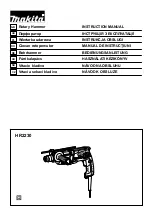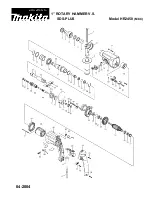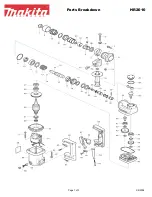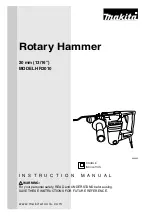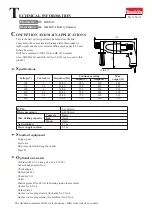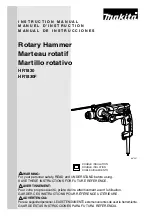
5
CAUTION:
•
Always set the knob fully to your desired mode
symbol. If you operate the tool with the knob
positioned halfway between the mode symbols, the
tool may be damaged.
•
Use the knob after the tool comes to a complete
stop.
Torque limiter
The torque limiter will actuate when a certain torque
level is reached. The motor will disengage from the
output shaft. When this happens, the bit will stop turning.
CAUTION:
•
As soon as the torque limiter actuates, switch off
the tool immediately. This will help prevent
premature wear of the tool.
•
Bits such as hole saw, which tend to pintch or
catch easily in the hole, are not appropriate for this
tool. This is because they will cause the torque
limiter to actuate too frequently.
ASSEMBLY
CAUTION:
•
Always be sure that the tool is switched off and
unplugged before carrying out any work on the
tool.
Side grip (auxiliary handle)
Fig.4
CAUTION:
•
Always use the side grip to ensure operating
safety.
Install the side grip so that the teeth on the grip fit in
between the protrusions on the tool barrel. Then tighten
the grip by turning clockwise at the desired position. It
may be swung 360° so as to be secured at any position.
Bit grease
Coat the bit shank head beforehand with a small amount
of bit grease (about 0.5 - 1 g).
This chuck lubrication assures smooth action and longer
service life.
Installing or removing the bit
Fig.5
Clean the bit shank and apply bit grease before installing
the bit.
Fig.6
Insert the bit into the tool. Turn the bit and push it in until
it engages.
After installing, always make sure that the bit is securely
held in place by trying to pull it out.
To remove the bit, pull the chuck cover down all the way
and pull the bit out.
Fig.7
Depth gauge
Fig.8
The depth gauge is convenient for drilling holes of
uniform depth. Loosen the side grip and insert the depth
gauge into the hole in the side grip. Adjust the depth
gauge to the desired depth and tighten the side grip.
NOTE:
•
The depth gauge cannot be used at the position
where the depth gauge strikes against the gear
housing.
Dust cup
Fig.9
Use the dust cup to prevent dust from falling over the
tool and on yourself when performing overhead drilling
operations. Attach the dust cup to the bit as shown in the
figure. The size of bits which the dust cup can be
attached to is as follows.
Bit diameter
Dust cup 5
6 mm - 14.5 mm
Dust cup 9
12 mm - 16 mm
006406
OPERATION
Hammer drilling operation
Position the bit at the desired location for the hole, then
pull the switch trigger. Do not force the tool. Light
pressure gives best results. Keep the tool in position and
prevent it from slipping away from the hole.
Do not apply more pressure when the hole becomes
clogged with chips or particles. Instead, run the tool at
an idle, then remove the bit partially from the hole. By
repeating this several times, the hole will be cleaned out
and normal drilling may be resumed.
CAUTION:
•
There is a tremendous and sudden twisting force
exerted on the tool/bit at the time of hole
break-through, when the hole becomes clogged
with chips and particles, or when striking
reinforcing rods embedded in the concrete. Always
use the side grip (auxiliary handle) and firmly hold
the tool by both side grip and switch handle during
operations. Failure to do so may result in the loss
of control of the tool and potentially severe injury.
NOTE:
Eccentricity in the bit rotation may occur while operating
the tool with no load. The tool automatically centers itself
during operation. This does not affect the drilling
precision.
Blow-out bulb (optional accessory)
Fig.10
After drilling the hole, use the blow-out bulb to clean the
dust out of the hole.
Summary of Contents for HR2230
Page 9: ...9 Fig 2 Fig 3 Fig 4 360 0 5 1 Fig 5 Fig 6 Fig 7 Fig 8...
Page 10: ...10 Fig 9 5 6 14 5 9 12 16 006406 Fig 10 Fig 11 Fig 12 13 32...
Page 11: ...11 SDS Plus S13 S13...
Page 31: ...31 Kif j k rte Porfog Porelsz v toldal k V d szem veg M anyag sz ll t b r nd Gyorstokm ny...
Page 40: ...40 Makita Corporation Anjo Aichi Japan 884703 975...

